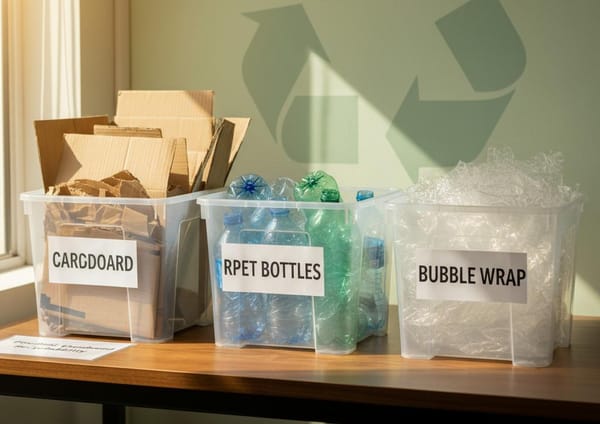How Do Renewable Materials Cut Plastic Waste?

Renewable Materials and Their Impact
Renewable materials are reshaping how we make everyday products, from reusable straws to furniture and packaging. Because they come from fast‑growing plants, recycled fibers, and other replenishable sources, they promise lower carbon footprints and less plastic waste. More companies and designers now choose biobased, compostable, and sustainably harvested options, and consumers reward those choices with loyalty and demand. As a result, industries move toward circular design and reuse models that cut landfill volume and reduce reliance on fossil‑fuel plastics.
The Daily Life Impact
This shift matters for your daily life. For example, swapping a disposable plastic straw for a durable stainless or plant‑based one saves resources over many uses. Likewise, replacing single‑use packaging with renewable alternatives can lower emissions and simplify recycling.
Understanding Tradeoffs
However, not all renewable materials perform the same. Some last decades, while others suit short‑lived items. Therefore, understanding tradeoffs — durability, end‑of‑life options, and carbon cost — helps you choose wisely. Read on to learn how renewable materials reduce plastics’ environmental footprint and how small swaps add up to big gains.
Benefits of Renewable Materials
Renewable materials unlock practical gains for designers, manufacturers, and everyday users. Because they come from plants, recycled fibers, or rapidly replenish-able sources, they lower carbon footprints and cut reliance on fossil‑fuel plastics. Moreover, they support circular design and more durable, repairable products.
Key types and where they shine
- Plant based polymers and bioplastics: made from corn, sugarcane, or cellulose. Used in packaging, disposable cutlery, and compostable straws. They often reduce greenhouse gases compared with virgin plastics.
- Recycled fibers and post consumer resin: used in textiles, carpet, and rigid packaging. They save resources and divert waste from landfill while keeping embodied carbon down.
- Natural fibers such as bamboo, hemp, and jute: strong and fast growing. They work well for furniture, construction panels, and reusable products like straws and cutlery.
- Wood and engineered timber: structural and durable. They replace steel and concrete in some builds and store carbon long term.
- Emerging options such as mycelium, algal materials, and biofoam: lightweight and compostable. These suit insulation, packaging, and specialty components.
Benefits at a glance
- Lower lifecycle carbon emissions
- Improved biodegradability or compostability
- Easier recycling and circularity when designed right
- Reduced plastic pollution and microplastics
- New revenue streams for agricultural supply chains
For deeper context on plastics replacement see this resource. To learn practical steps you can take, visit this guide and this page. For circular economy frameworks and policy guidance, see the Ellen MacArthur Foundation and the United Nations Environment Programme.
| Material pair | Environmental impact | Cost | Availability | Durability | End of life |
|---|---|---|---|---|---|
| Bioplastics (PLA, PBAT) vs Conventional plastics (PET, PP) | Lower lifecycle carbon; less fossil input; however industrial composting often needed | Similar to slightly higher | Growing, but supply limits for scale | Good for short-term items; heat sensitive | Often industrially compostable or recyclable; check local rules |
| Bamboo vs Tropical hardwood | Lower carbon, fast-growing, renewable; less deforestation pressure | Competitive, sometimes lower | Widely available in many regions | Strong and durable for furniture with treatment | Biodegradable and recyclable; can be reused |
| Reclaimed or recycled wood vs Virgin timber | Saves embodied carbon and diverts waste | Often lower after reclaim costs | Increasing in urban areas | Comparable when reused; may need repair | Reusable, recyclable, lower landfill impact |
| Cork vs Synthetic foams | Low carbon; cork harvest is sustainable and supports biodiversity | Moderate, varies | Regionally abundant in Mediterranean areas | Durable and resilient | Biodegradable and recyclable |
| Mycelium and algal materials vs Polystyrene foam | Much lower emissions; compostable and renewable | Emerging tech can be cost-competitive | Limited but expanding | Good for short-term protective use | Home or industrial compostable; fully biodegradable |
| Stainless steel reusable vs Single-use plastic | Higher production emissions but lower over many uses | Higher upfront cost; low lifetime cost | Widely available | Very durable; decades of use | Fully recyclable; long service life |
Challenges and Future Potential of Renewable Materials
Adoption of renewable materials faces clear hurdles today, yet the path forward looks promising. First, feedstock and scale limit production. Many biobased polymers and natural fibers rely on agricultural inputs, which compete with food crops and need land, water, and fertilizers. As a result, costs can stay higher than fossil alternatives and supply can fluctuate.
Second, end-of-life systems remain uneven. For example, industrial composting is required for many PLA and PBAT products, but collection and processing infrastructure are scarce in many regions. Therefore, items marketed as compostable sometimes end up in landfill, where they offer little climate benefit.
Third, technical performance and standards can lag. Some renewable materials are heat sensitive, porous, or less durable than petrochemical plastics. Consequently, designers must balance biodegradability with longevity, especially for reusable products like straws and packaging.
However, innovation and policy are closing gaps. Advances in advanced recycling and chemical recycling are helping recycle mixed streams, while research into algae, mycelium, and biofoam improves performance and cost. A leading case example is Ecovative, which commercializes mycelium composites for packaging and insulation: Ecovative Design.
Public policy and circular design also matter. Stronger standards and incentives can scale supply chains and reduce feedstock risk. For practical guidance on reducing impact and design choices, see this primer: Primer on Reducing Environmental Footprint.
To understand plastics replacement tradeoffs in detail, read: Renewable Materials and Plastics.
Looking ahead, renewable materials can reach mainstream use if producers, policymakers, and waste managers coordinate. International frameworks like the Ellen MacArthur Foundation’s circular economy work (Ellen MacArthur Foundation) and UNEP’s guidance (UNEP) help set standards and scale solutions.
Taken together, the challenge is manageable. With better standards, improved recycling, and continued material innovation, renewable materials can cut plastic waste and lower lifecycle emissions at scale. For everyday steps you can take now, visit Steps to Cut Environmental Footprint.
Renewable Materials and Their Impact
Renewable materials offer clear environmental gains and practical value. They cut lifecycle carbon, reduce plastic pollution, and open paths to circular design. However, tradeoffs remain because scale, feedstock pressures, and uneven end-of-life systems can limit impact.
Still, the momentum is real. Businesses increasingly adopt biobased polymers, recycled fibers, and natural alternatives, and consumers reward those moves with loyalty. Therefore, shifting to renewable materials matters for climate goals and waste reduction. Small choices add up: choose reusable straws, buy products with recycled content, and favor durable biobased items when possible.
You can act today. Audit your purchases, prioritize repairable and recyclable options, and ask brands about sourcing and composting routes. Support policies that build industrial composting and advanced recycling infrastructure. Together, these steps scale supply and lower costs.
Ultimately, renewable materials are not a single fix but a vital part of a sustainable future. Embrace them deliberately, and you help turn innovation into everyday impact.



